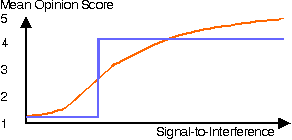
Protection ratio
In mobile telephony, the quality of service is often expressed in terms of the probability of outage
experienced by subscribers near the boundary of the base station service area. Because of limited
spectrum availability, radio networks become increasingly limited by mutual interference between
users. Therefore, the outage probability is usually determined in terms of the probability that the
signal-to-joint-interference ratio drops below a minimum required ratio z. If noise is also significant,
an outage occurs when the signal-to-noise-plus-interference ratio C/(I + N) drops below the threshold
z.
The receiver parameter appears in many studies throughout the technical literature. The parameter
is called
- the "co-channel rejection ratio",
- the "receiver threshold",
- the "threshold ratio",
- the
"capture ratio",
- the "interference criterion", or
- the "protection ratio".
The parameter 'protection ratio', however, is principally intended as a parameter in system design or
network planning, describing the minimum required (average) C/I-ratio, rather than merely a
receiver parameter. For instance, as indicated by the CCIR in Report 358-5, fade margins may be
implicitly included in the required protection ratio to allow for the effects of multipath fading or
terrain irregularities.
The terms
'threshold' and 'capture' were originally used in studies of the demodulation of FM broadcast
transmissions.
The choice of the value of z, in general, depends on the required quality of service and may therefore
be somewhat arbitrary. The 'outage criterion' can, for instance, be a certain figure of merit subjectively
determined by a representative panel of listeners or, in a digital system, an instantaneous bit error
rate or digital-word erasure rate.
Typical Receiver Thresholds
In general, the receiver threshold considered depends both on the required output performance, i.e., at base-
band, and on the type of interference. If the characteristics of the interference resemble AWGN, the
relation between the required signal-to-noise ratio at the detector output (SNR) and expressions for z are well known.
For linear modulation, such as AM and
SSB, and any Gaussian interference, the relation between the SNR at the detector output and the (RF)
C/I-ratio is linear. However, in non-linear modulation, such as phase modulation (PM) or frequency
modulation (FM), the post-detection signal-to-noise ratio can be greatly enhanced as compared to
baseband transmission or compared to linear modulation. This enhancement occurs as long as the
received pre-detection signal-to-noise ratio is above a certain minimum value, called the 'threshold'.
Typically, for FM signals, the threshold is in the range of 3 to 10 dB. This threshold
fundamentally limits the noise immunity of various types of non-linear modulation techniques.
Table: Typical receiver thresholds below which a voice baseband signal becomes almost unintelligible.
Source: Gosling
| FM | 25 kHz | 3 .. 8 dB
|
| FM | 12.5 kHz | 6 .. 15 dB
|
| SSB | 5 kHz |
|
| heavy companding | 8 .. 11 dB
|
| | moderate companding | 11 .. 15 dB
|
| | no companding | 15 .. 20 dB |
Typical receiver thresholds for SSB, a modulation technique which was used in some early North American mobile
telephone systems, are in the order of 20 dB. With exponential modulation, which is more
commonly used in mobile radio nets, the receiver threshold can be reduced but cannot be
substantially lower than 5 to 10 dB. The CCIR indicates in Report 319 that the threshold is around
80 (about 19 dB)
for FM voice signals with an occupied bandwidth of 12.5 kHz
and 7 to 8 (8 to 9 dB) for FM voice signals with BT 25 to 30 kHz.
A receiver threshold of 17 dB (z = 50) is used in the U.S. AMPS cellular radio network employing
FM voice with a peak deviation of 12 kHz (and a channel spacing virtually identical to the occupied
bandwidth of 30 kHz). For a C/I-ratio higher than 17 dB, most subscribers experience the quality
of voice reception as 'good' or 'excellent'. An outage probability of 10% is tolerated for a
Rayleigh-fading channel. The receiver threshold below which the received voice becomes
'unintelligible' is much lower and may be in the order of 6 to 10 dB. If,
however, this outage criterion is used, tolerable outage probabilities will be significantly smaller,
typically 1 or 0.1%.

Figure: Mean Opinion Score of speech quality as a function of C/I ratio
for (indigo) digital and analogue (orange) systems.
For digital modulation, the receiver threshold may be defined as the instantaneous C/I-ratio at which
the short-term average bit error probability or the block erasure probability exceeds a maximum
tolerable value, which is called the outage criterion.
- If interference has a Gaussian
probability density and if the interference signal is independent from bit to bit, the relation between
outage probability and required C/I threshold is in the form of an error-function if coherent detection is used.
- On the other hand, for
a single interferer with a peak-limited signal, such as a constant-envelope BPSK signal, the bit error
rate is nearly a step function of the C/I-ratio.
If the C/I-ratio is above a certain threshold value, error rates are negligible, whereas below this threshold, bit errors rapidly tend towards 50%.
For
the digital pan-European GSM system using GMSK modulation, a receiver threshold of 9.5 dB is
considered to describe the performance of practical receivers appropriately.






